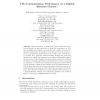Free Online Productivity Tools
i2Speak
i2Symbol
i2OCR
iTex2Img
iWeb2Print
iWeb2Shot
i2Type
iPdf2Split
iPdf2Merge
i2Bopomofo
i2Arabic
i2Style
i2Image
i2PDF
iLatex2Rtf
Sci2ools
85
Voted
EUROPAR
2001
Springer
2001
Springer
VIA Communication Performance on a Gigabit Ethernet Cluster
As the technology for high-speed networks has evolved over the last decade, the interconnection of commodity computers (e.g., PCs and workstations) at gigabit rates has become a reality. However, the improved performance of high-speed networks has not been matched so far by a proportional improvement in the ability of the TCP/IP protocol stack. As a result the Virtual Interface Architecture (VIA) was developed to remedy this situation by providing a lightweight communication protocol that bypasses operating system interaction, providing low latency and high bandwidth communications for cluster computing. In this paper, we evaluate and compare the performance characteristics of both hardware (Giganet) and software (M-VIA) implementations of VIA. In particular, we focus on the performance of the VIA send/receive synchronization mechanism on both uniprocessor and dual processor systems. The tests were conducted on a Linux cluster of PCs connected by a Gigabit Ethernet network. The perform...
Distributed And Parallel Computing | EUROPAR 2001 | Performance | TCP/IP Protocol Stack | VIA Send/receive Synchronization |
Related Content
| Added | 28 Jul 2010 |
| Updated | 28 Jul 2010 |
| Type | Conference |
| Year | 2001 |
| Where | EUROPAR |
| Authors | Mark Baker, Paul A. Farrell, Hong Ong, Stephen L. Scott |
Comments (0)

